The following is an excerpt from my new book The Shadow in Review. If you’d like more information about the book, see the end of this blog entry for my shameless promotion. But for now, let’s get right into Walter Gibson‘s final mystery featuring The Shadow.
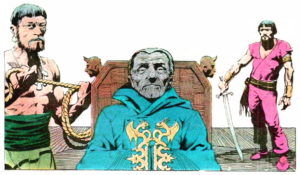
“Gray Face” was originally published in the March 1981 issue of Detective Comics. A man of mystery, an international pirate, his features were fixed, smooth as parchment with the hue of dried ashes. His name came from trembling lips: “Gray Face!”
This was the last Shadow story that creator Walter B. Gibson ever wrote, re-written as a Batman story. It was conceived by Gibson with The Shadow in mind. The similarities between The Shadow and Batman are well documented. So creating a story about The Shadow and then changing it to a Batman tale wasn’t all that hard. Just change a few names and locations. Supposedly, Gibson even left behind some notes on how this “Batman” story could easily be changed back to a “Shadow” story.
It was a special anniversary issue of Detective Comics, being #500. Walter Gibson was hired to write a text story for the comic. So, sandwiched between graphic stories “The Final Mystery of Edgar Allen Poe!” and “The Strange Death of Dr. Erdel” was an eight-page text story of how Batman encountered Gray Face. But to those in “the know,” this was actually Gibson’s final Shadow story… with some cosmetic changes made so as to feature Batman and fit the anniversary issue of Detective Comics.
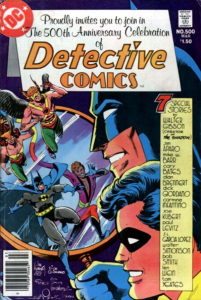
That having been established, for the rest of this review I’m going to refer to this story as a Shadow adventure. That’s the way I want to see it. So while I may refer to The Shadow, in the back of your mind, you’ll realize that in the printed version of this tale, it says the Batman.
A Chinatown tale
“Gray Face” is a Chinatown tale, something at which Gibson excelled. The two dozen or so pulp novels of The Shadow that took place in Chinatown are some of the most fondly remembered of all the 325 Shadow mysteries. And this one is a pretty good exploit of our favorite master of the night, considering that it’s of short-story length. Perhaps the plot is a bit simplistic and the prose is pretty straightforward, but then that’s to be expected when you try to jam this much story into only 6,000 words. By the time this was written, Gibson was 84 years old, but he still had the writing chops to give readers a rousing good adventure.
There is no proxy hero in this tale, as was common in the old pulp magazine stories. There isn’t room for that. So it’s The Shadow who we follow as he tracks down the villain of the piece. And who is this mystery figure… this man of evil that The Shadow will challenge? He’s a man with ashen features, an international crime figure known in over a dozen languages as “Gray Face.”
As our story opens Gray Face is wearing an Oriental robe and sitting in a teak-wood chair amid garish Oriental decorations. His Malay henchmen have taken Hubert Garland prisoner. Garland is from the New Hebrides Islands. He’s a seaman who speaks in English, but French sneaks into his conversations quite often.
As the story opens, he sits before Gray Face… a man that he recognizes as “Le Visage Gris.” Gray Face is “Keeper of the Blue Pearl” a gleaming pearl the size of a large marble that assures the loyalty of his Malay minions. He is a pirate who plunders the seas of Southeast Asia. And now, he’s here in New York’s Chinatown to extort money from respectable Chinese merchants and honest American importers. Poor Hubert Garland was supposed to deliver a confidential letter to the owner of the shipping line, and innocently got caught up in the plottings of Gray Face. A case of just being in the wrong place at the wrong time.
Later that night, police rescue Garland as his barely-alive body is about to be dumped into the river. The Shadow, garbed in his usual black raiment, visits him at Central Hospital, where he still madly raves about his deadly encounter with Gray Face.
Lamont Cranston, who of course is merely a disguise for The Shadow, has been brought into the case by Commissioner Weston. Weston is aware of the plot to extort money from honest businessmen, and seeks Cranston’s advice. Little does he realize he’s talking to The Shadow!
Garland tells his story
So, back at the hospital, Garland tells The Shadow of his horrifying experience. He explains that he was a seaman on the freighter Malabur of the Indonesian Line. He had been carrying a confidential letter to the owner of the line, Blair Gownset. But Gray Face had abducted him as soon as he had docked, and had taken that letter. That’s all he knows, but it’s enough to set The Shadow on the trail of Gray Face.
Cranston takes to strolling through Chinatown, hoping that Blair Gownset, the shipping magnate, will show up seeking an audience with Gray Face. And on the third night, he does. The Shadow, master of the night, follows stealthily, as only The Shadow can. First he follows the man to the outskirts of Chinatown, then through a restaurant into a private alcove, down a passageway hidden beneath a marble fountain, and into a series of death traps… traps that Blair Gownset avoided, for he was an anticipated visitor. But The Shadow is an unwelcome guest, and doom promises to be his destiny.
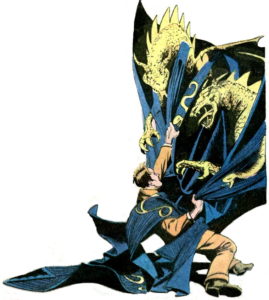
Sliding steel doors seek to trap The Shadow and entomb him underground. High voltage electricity, bursts of toxic gas, a deep pit studded with long, upright steel spikes, yes, our hero is really put to the test. Finally, he safely reaches the Dragon Room, which Herbert Garland had described to him back at the hospital. Burning candles give off fumes… a form of hashish, which produces hallucinations and unconsciousness. Dizzy from the effects of the drug, The Shadow is captured by minions of Gray Face. He is securely tied, and left for an hour. Gray Face promises that if he can escape his bonds within that time period, he will live, will own the Blue Pearl, and will command the loyalty of the Malays who follow the orders of whomever owns the Blue Pearl. Failure, however, means a swift and horrible death.
The Shadow has faced death many times in his long and storied career. And now, in this final but unofficial Shadow adventure, he faces it yet again. We know, of course, that our crimefighter supreme and scourge of the criminal underworld will escape even certain death. He will live to fight another day, even though those adventures were never chronicled by Walter Gibson. And so, in amazing Houdini fashion, he evades death once more.
Differences easily reconciled
In the “Batman” version of this tale, our hero, the Batman, calls Lucius Fox, his chief operating officer at Wayne Enterprises. He has Fox create a computerized list of people that Gray Face might be threatening. That’s the version that saw print. But I’m sure that in this story, as written for The Shadow, it would have been Rutledge Mann called. And he would have gathered news clippings and compiled a report from them… no computer necessary.
And, similarly, a throw-away line “Alfred is here with the Rolls” could easily have become “Stanley is here with my limousine.”
It would have been nice to see some of the old familiar characters, such as Harry Vincent or Margo Lane. But the only one who shows up is New York Police Commissioner Ralph Weston. Okay, it was Commissioner Gordon who was actually named. But we all know it was really Commissioner Weston, don’t we?

Since there was no Batman equivalent for most of The Shadow’s other agents, there was no room for them in this tidy little adventure. Too bad, but understandable.
There’s no sign of other items that were specific to The Shadow. No girasol ring. No explosive “Devil’s Whisper” paste. No messages in disappearing ink. In the “Batman” version, he reviewed that computerized report in his penthouse suite. Obviously if Gibson had used this as a Shadow story, this scene would have taken place in The Shadow’s sanctum. In my mind, it’s clearly the sanctum, with its blue light shining down onto a polished tabletop.
… And the surprise ending!
There’s a surprise ending. Of course there is. In Gibson’s best Shadow tales, there’s always a surprise ending. And this one is no exception. Yes, maybe it’s one you saw coming… or suspected it was coming… but it is still very satisfying to read.

And so, while this wasn’t an official Shadow story, it was created for The Shadow. It’s still very worthwhile for any Shadow fan to read and enjoy. Use your imagination, and for one final time, The Shadow delivers his own brand of justice yet again. Oh yeah, I forgot. It wasn’t The Shadow. It was Batman. Right. Wink… wink…
The above was taken from my recently-published book The Shadow in Review: The Ultimate Guide to the Pulp Magazine Series. You can order it direct from the printer for only $10. For more information, click here.
Every pulp aficionado should have a few pulp reference books in his/her bookcase… and this should be one of them!
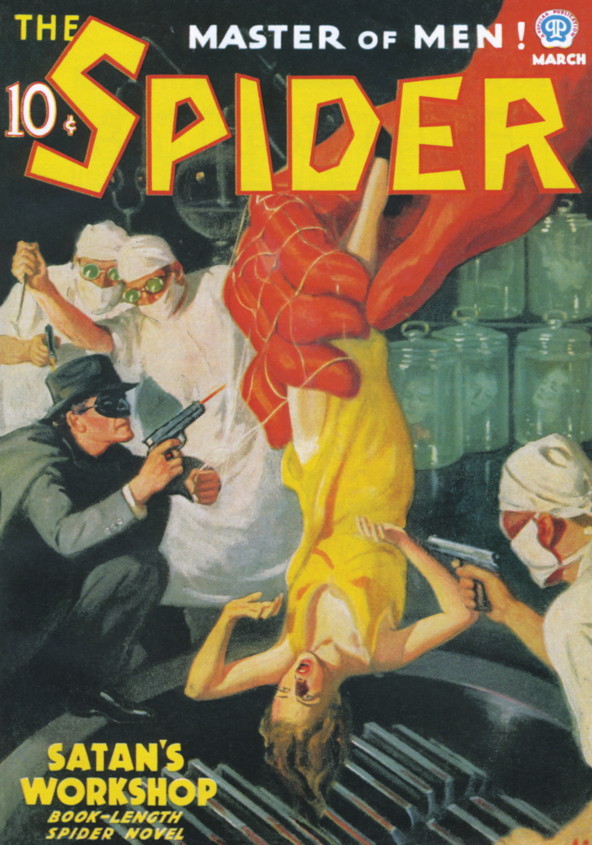
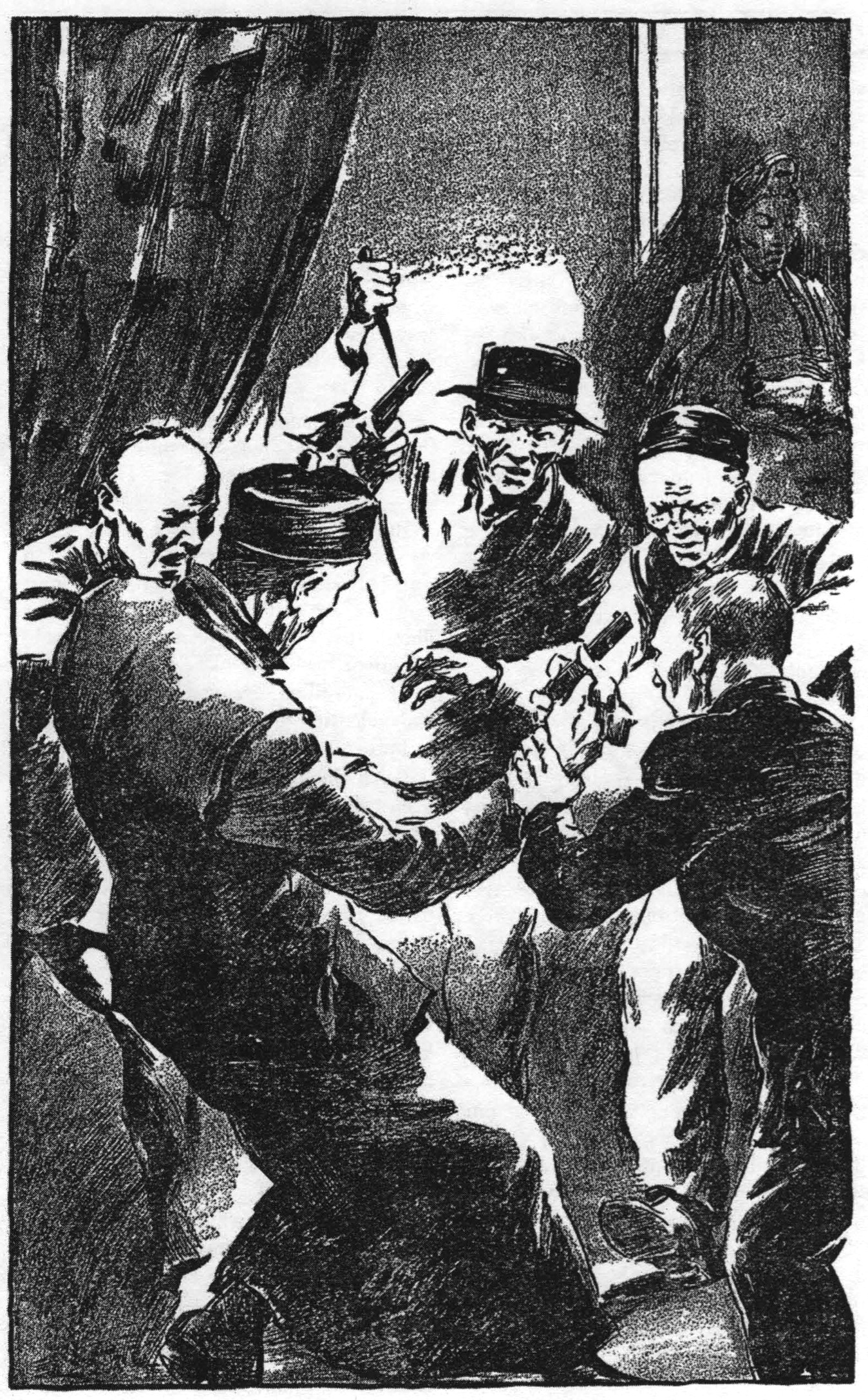

Eagerly awaiting my copy of the book, it’s supposed to arrive today!
Thanks for ordering a copy. Hope you enjoy it.
Got my copy. My review will be going up on the Pulp Super-fan blog soon.
Glad to hear it arrived safely. I guess the post office is getting pretty good at delivery, nowadays. They’re using tracking numbers on even lowly “media mail” now, a trick they learned from UPS and FedEx. But I can remember a time when mailing out a book wasn’t a guaranteed delivery. Back in the 70s when I was trading open-reel tapes of old radio shows, I lost more than one package. I guess the “good old days” weren’t uniformly good, after all.
Anyway, as you write your review, remember my credo: “If you like it, give me the credit. If you hate it, we’ll blame somebody else.”
I have a copy of “Partners In Peril”, the Shadow novel that copied for the Batman’s comic debut. “Partners” was also the first Shadow story not to be written by Gibson; it was penned by Theodore Tinsley.
Ted Tinsley — now there was a guy who knew how to write for the pulps! I loved reading his Shadow stories. They had that slightly more lurid touch that just cried “pulp!” Out of the 27 stories he wrote for The Shadow, there were very few duds. And “Partners of Peril” was a favorite of mine. Good stuff!
Looking forward to reading your doorstopper about a crimestopper
Ah, a man who knows how to turn a phrase! I’m impressed. You must be a writer. I tried to think of a snappy comeback, but failed miserably. How sad is that?
Thank you for writing such an extensive work of Shadow review, which I had read before in another form on the internet. But you will be pleased that your book has found his place on Goodreads.
I appreciate the kind words, Mark. When the old “Shadow in Review” website went down, I hated to see the reviews just fade away. So I did some updating and editing… and added a hundred pages of appendices… and voila! A book was born!
I don’t expect everyone to agree with my opinions — what a boring world -that- would be. But it’s nice to have my views on The Shadow preserved in book form.
And thanks for the review on Goodreads. Also, much appreciated!